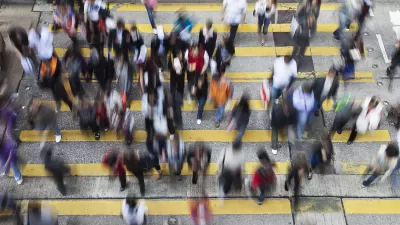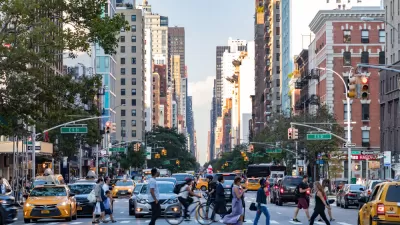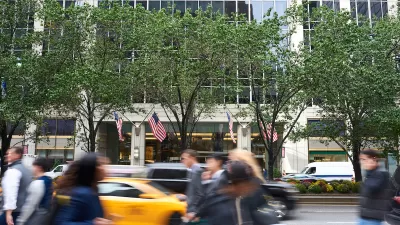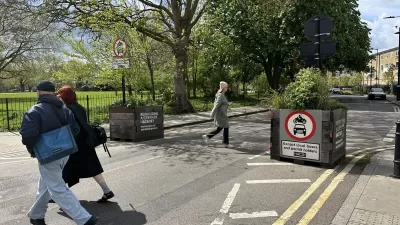Anti-jaywalking laws are based upon questionable assumptions.

The conventional wisdom among many urban planners is that walkable places are going to continue to become more popular and prosperous. But a new obstacle to pedestrian life has emerged in some cities—the police.
In both New York and Los Angeles, city police have been aggressively ticketing so-called “jaywalkers”—that is, pedestrians who cross when the light facing them says “Don’t Walk,” or cross in the middle of a block. Once in a while, the police go beyond issuing tickets: a couple of weeks ago, the police beat an 84-year-old, non-English speaking pedestrian bloody after he allegedly jaywalked and then failed to understand an officer’s directions.
The basic assumption behind these policies is that pedestrians are safe if they don’t jaywalk, and unsafe if they do. But this claim is not necessarily correct.
Why not? Because traffic lights are not very accurate guides to safety. Suppose you are at an intersection, and the light across the street from you says “Walk.” That usually means that there is a red light above you, and that the traffic heading towards you cannot move. For example, if I am crossing a north-south street (such as Manhattan's Ninth Avenue where I live) and the light across from me says “Walk”, I probably will not be hit head on by someone driving on an east-west street.
But that fact alone does not make me safe from cars, because a motorist turning left or right into Ninth Avenue might be governed by a green light which allows him or her to turn. So if I cross when the light says “Walk”, I can easily be crushed by a driver making a turn. In fact, turning motorists may be even more risky for pedestrians than a head-on attack, since they are harder to notice.
Another form of so-called jaywalking is crossing a street mid-block. Where traffic is fast and heavy, crossing mid-block can indeed be dangerous. On the other hand, crossing midblock may actually be safer when traffic is light, because a pedestrian need only look in two directions (or only one, where each side of the street is separated by a median) at a time to be sure that there are no cars coming. By contrast, at a four-way intersection, the pedestrian must look in several directions to avoid being attacked by a car.
It logically follows that anti-jaywalking laws are unlikely to make pedestrians safer. In fact, such laws may actually reduce safety by discouraging walking. If people have to worry about police harassment every time they walk, they are less likely to walk and more likely to either drive themselves or (in a less car-oriented city such as New York) patronize taxis.
And the more drivers there are on the streets, the more potential risk they create to both pedestrians and other drivers. This is the case for two reasons. First, where there are more cars on the streets, there is a higher chance that one of those cars could be driven carelessly. Second, where pedestrians are rare, drivers are less likely to expect them and thus more likely to drive rapidly, creating additional risk not only for pedestrians but even for other drivers as well. Thus, the most car-dependent places have the most car crashes. For example, in the United Kingdom (where jaywalking is legal) road fatalities are one-fourth the American level. Pedestrian fatalities are also lower- the UK had 420 pedestrian fatalities in 2012, or roughly 7 per 1 million people, while the US had 4743, or about 15 per 1 million people.
Thus, it seems clear to me that anti-jaywalking laws discourage walking, while it is anything but clear that they increase safety. Thus, cities should terminate their jaywalking ordinances, so that American pedestrians will not have to worry about police harassment every time they leave home.
More broadly, our politicians and police officers have to face the reality that cars are big enough and fast enough to kill someone, while pedestrians are significantly less lethal. So to make the streets safer, regulate cars not pedestrians.

Planetizen Federal Action Tracker
A weekly monitor of how Trump’s orders and actions are impacting planners and planning in America.

San Francisco's School District Spent $105M To Build Affordable Housing for Teachers — And That's Just the Beginning
SFUSD joins a growing list of school districts using their land holdings to address housing affordability challenges faced by their own employees.

The Tiny, Adorable $7,000 Car Turning Japan Onto EVs
The single seat Mibot charges from a regular plug as quickly as an iPad, and is about half the price of an average EV.

With Protected Lanes, 460% More People Commute by Bike
For those needing more ammo, more data proving what we already knew is here.

In More Metros Than You’d Think, Suburbs are Now More Expensive Than the City
If you're moving to the burbs to save on square footage, data shows you should think again.

The States Losing Rural Delivery Rooms at an Alarming Pace
In some states, as few as 9% of rural hospitals still deliver babies. As a result, rising pre-term births, no adequate pre-term care and "harrowing" close calls are a growing reality.
Urban Design for Planners 1: Software Tools
This six-course series explores essential urban design concepts using open source software and equips planners with the tools they need to participate fully in the urban design process.
Planning for Universal Design
Learn the tools for implementing Universal Design in planning regulations.
Smith Gee Studio
City of Charlotte
City of Camden Redevelopment Agency
City of Astoria
Transportation Research & Education Center (TREC) at Portland State University
US High Speed Rail Association
City of Camden Redevelopment Agency
Municipality of Princeton (NJ)






























